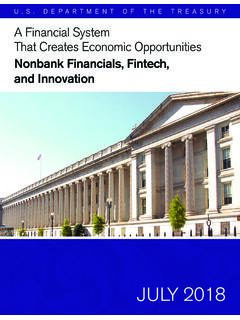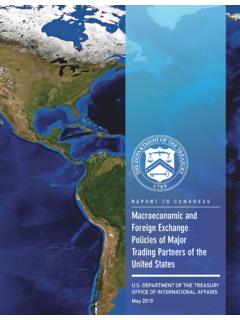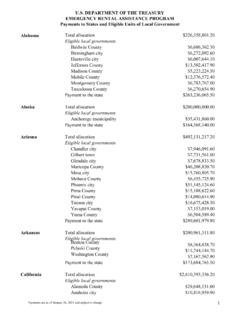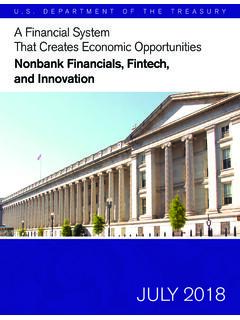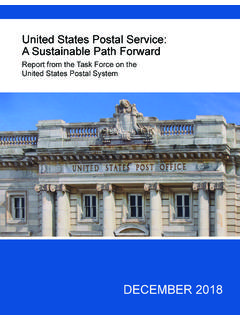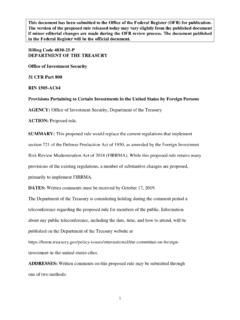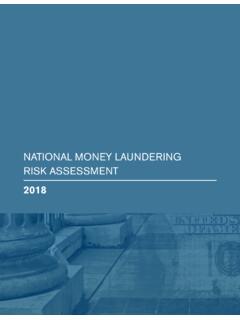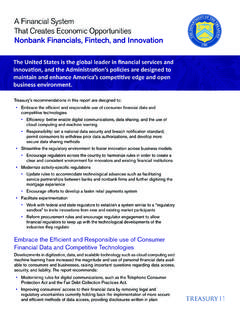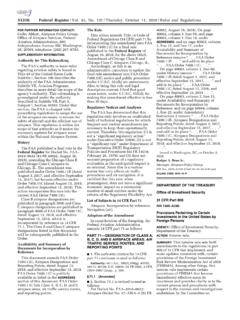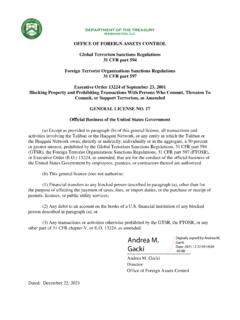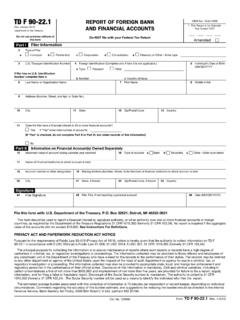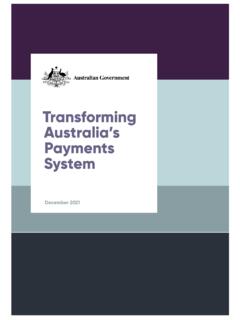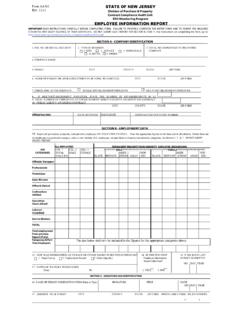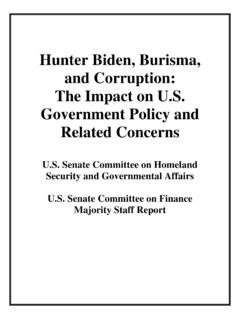Transcription of U.S. DEPARTMENT OF THE TREASURY
1 DEPARTMENT OF THE TREASURYAPRIL 2021 The made In america Tax plan I 1 Executive Summary and Introduction Last week, President Biden proposed the American Jobs plan , a comprehensive proposal aimed at increasing investment in infrastructure, the production of clean energy, the care economy, and other priorities. Combined, this plan would direct approximately 1 percent of GDP towards these aims, concentrated over eight years. This report describes President Biden s made in america tax plan , the goal of which is to make American companies and workers more competitive by eliminating incentives to offshore investment, substantially reducing profit shifting, countering tax competition on corporate rates, and providing tax preferences for clean energy production. Importantly, this tax plan would generate new funding to pay for a sustained increase in investments in infrastructure, research, and support for manufacturing, fully paying for the investments in the American Jobs plan over a 15-year period and continuing to generate revenue on a permanent basis.
2 To start, the plan reorients corporate tax revenue toward historical and international norms. Of late, the effective tax rate on profits of multinationals the share of profits that they actually pay in federal income taxes was just And although companies are the most profitable in the world, the United States collects less in corporate tax revenues as a share of GDP than almost any advanced economy in the Organization for Economic Co-operation and Development (OECD). At the same time, the corporate income tax system incentivizes shifting of profits and investment abroad and allows other countries to undercut corporate tax rates here. For instance, a corporation making a physical investment abroad pays no tax on the first 10 percent return on foreign investment. And, both and foreign corporations still have substantial incentives to report profits in low tax countries and strip profits out of the United States; the latest data suggest that such profit shifting remains at record levels.
3 Lastly, the current system maintains a series of incentives that distort economic outcomes. Our tax system contains tax preferences for fossil fuel producers and lacks sufficient incentives for climate-change mitigation. In contrast, the made in america tax plan contains tax provisions that incentivize clean energy. It also introduces new market-based incentives for corporate research and development expenditures, complementing the spending proposals advanced in the American Jobs plan . The President s made in america tax plan is guided by the following principles: 1. Collecting sufficient revenue to fund critical investments. A primary objective of the made in america tax plan is to promote competitiveness by funding critical new investments. Corporate tax revenues have fallen dramatically from 2 percent of GDP in the years before the Tax Cuts and Jobs Act (TCJA) to 1 percent in the years since the enactment of TCJA.
4 2. Building a fairer tax system that rewards labor. In recent decades, the share of national income derived from labor has declined relative to that derived from capital. The plan would counter the incentives in our tax code that contribute to that Reducing profit shifting and eliminating incentives to offshore investment. The enactment of a country-by-country minimum tax aims to substantially curtail profit shifting by multinational corporations. By tackling the profit shifting of foreign multinational companies out of the tax base, the plan works to level the playing field between multinational 1 See Joint Committee on Taxation. 2021. International Tax Policy: Overview and Analysis. JCX-16-21, made In america Tax plan I 2companies headquartered in the United States and foreign countries. The President s plan would also eliminate the tax laws embedded in the 2017 TCJA that incentivize the offshoring of Ending the race to the bottom around the world.
5 Countries too often compete for multinationals business by reducing corporate tax rates which makes it difficult for the United States and other countries to meet revenue needs. The President s plan provides a strong incentive for nations to join a global agreement that implements minimum tax rules worldwide through the denial of deductions on related party payments to foreign corporations residing in a regime that has not implemented a strong minimum tax. This aspect of the plan is designed to help level the playing field between foreign and Requiring all corporations to pay their fair share. To ensure that large, profitable companies pay a baseline amount of taxes, the President s plan would impose a minimum tax on firms with large discrepancies between income reported to shareholders and that reported to the IRS. It would also provide the IRS with resources to pursue large corporations who do not meet their tax obligations, reversing a trend toward fewer corporate audits.
6 6. Building a resilient economy to compete. To complement initiatives in the American Jobs plan that would change the path of energy production in the United States and provide resources for a new research and development agenda, the tax plan would end long-entrenched subsidies to fossil fuels, promote nascent green technologies through targeted tax incentives, encourage the adoption of electric vehicles, and support further deployment of alternative energy sources such as solar and wind power. The made In america Tax plan I 3 The made In america Tax PlanThe current corporate income tax regime contains incentives for corporations to shift their production and profits overseas. Declining corporate tax revenues hinder the ability of the United States to fund investments in infrastructure, research, technology, and green energy. The made in america tax plan would fundamentally reorient corporate taxation to reverse this made in america tax plan implements a series of corporate tax reforms to address profit shifting and offshoring incentives and to level the playing field between domestic and foreign corporations.
7 These include:1. Raising the corporate income tax rate to 28 percent;2. Strengthening the global minimum tax for multinational corporations;3. Reducing incentives for foreign jurisdictions to maintain ultra-low corporate tax rates by encouraging global adoption of robustminimum taxes;4. Enacting a 15 percent minimum tax on book income of large companies that report high profits, but have little taxable income;5. Replacing flawed incentives that reward excess profits from intangible assets with more generous incentives for new researchand development;6. Replacing fossil fuel subsidies with incentives for clean energy production; and7. Ramping up enforcement to address corporate tax are the major elements of the made in america tax plan , but the proposal contains several additional tax incentives that would directly benefit corporations, passthrough entities, and small businesses.
8 These include, for example, a marked increase in the resources available through the Low-Income Housing Tax Credit and other housing incentives. This report , however, is focused on the elements of the package directly related to corporate tax reform and reforming energy incentives. The made In america Tax plan I 4 Addressing Flaws In The Current SystemThe made in america tax plan advances a series of reforms aimed at addressing the major flaws in the corporate tax code, including both shortcomings introduced through the TCJA and longstanding inefficiencies that have persisted for decades. The President s plan would make the tax code more efficient, reverse biases against labor, raise sufficient revenue to pay for critical initiatives, eliminate incentives for profit shifting and offshoring, and introduce new preferences for the production of clean energy. Combined, these reforms will have substantial benefits for the American economy.
9 Toward a More Efficient Tax System The reforms in the made in america tax plan are aimed at improving economic efficiency. Much of the efficiency argument for low corporate statutory rates is based on the premise that corporate investment incentives are driven by the corporate tax rate. Supporters of this line of thinking contend that higher corporate tax rates decrease investment incentives, and lower corporate tax rates improve them. Evidence following the 2017 corporate rate cut from 35 percent to 21 percent, however, did not show an increase in investment or economic growth from trend levels, with one analysis concluding that there is no evidence that the 2017 tax law has made a substantial contribution to investment or longer-term economic growth. 2 In fact, a report from the International Monetary Fund (IMF) found that less than one-fifth of the increase in corporate cash balances, which were enhanced by the corporate tax cut, was used for capital and research and development (R&D) spending.
10 Instead, the increased corporate cash balances were directed toward financing buybacks and dividend payouts for It is unsurprising that corporate tax cuts would not spur a surge in investment since much of the corporate tax falls on excess profits, not normal returns. Taxing these excess profits can generate revenue without undue distortion, according to research. Moreover, a rising share of the corporate tax base, over three-quarters by 2013, consists of excess returns. That fraction is likely even higher now, due to the rising market power of large companies, as well as special provisions that exempt most normal returns from Although the 2017 corporate tax rate cut purported to increase the competitiveness of companies, the law s generous treatment of corporate profits was paired with incentives for shifting profits and activities offshore. Instead of a focus on encouraging investments in the United States, for example, the 2017 TCJA created new offshoring incentives through two provisions, the global 2 See detailed evidence within: Furman, Jason.
